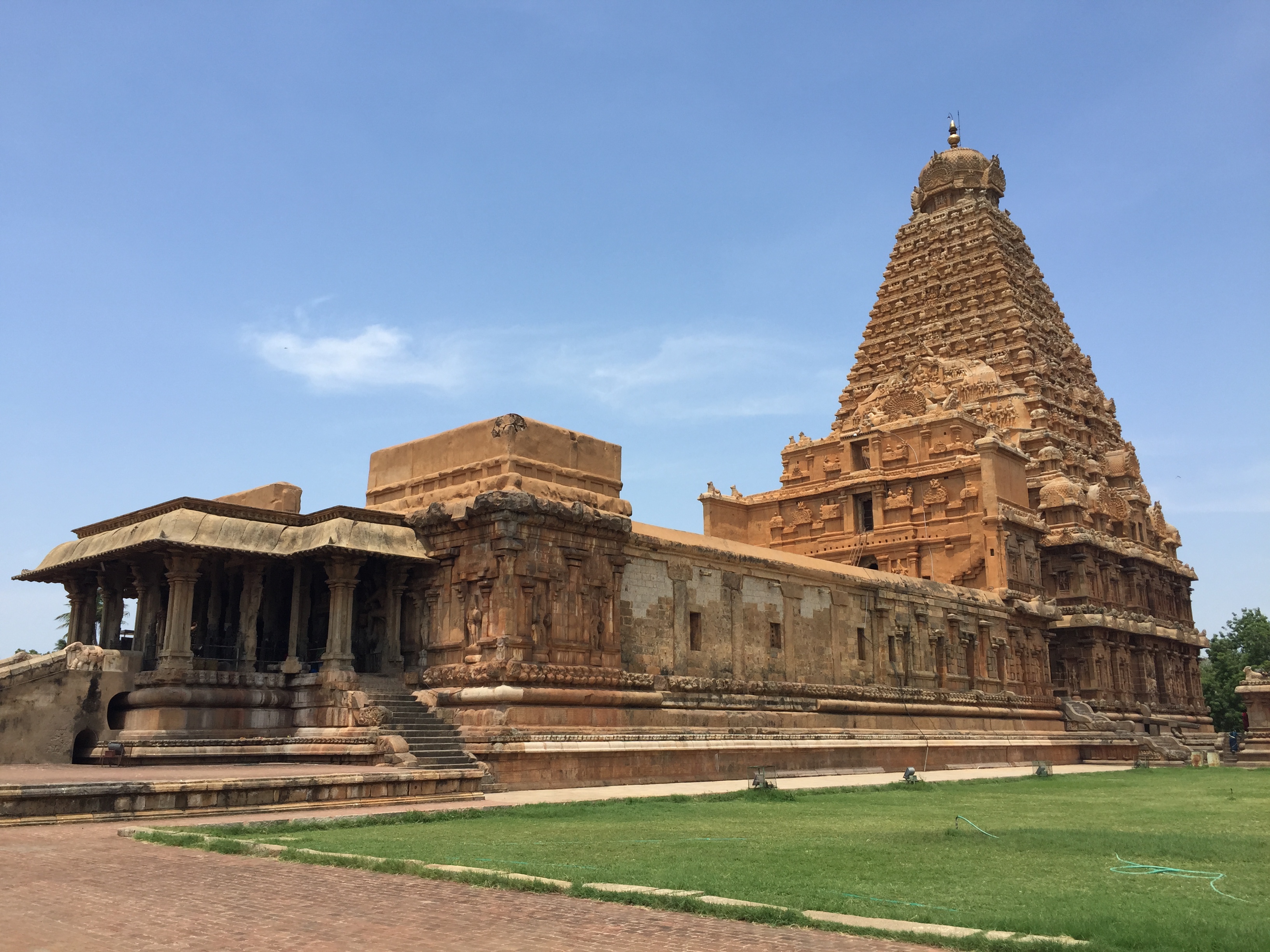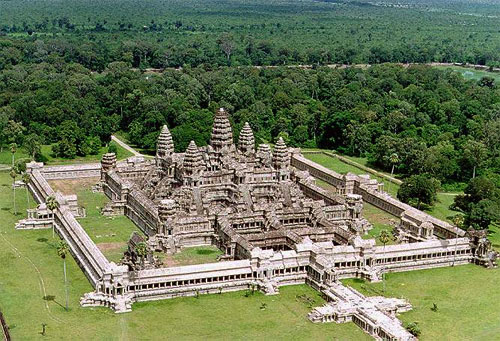Famous Temple
1. Brihadeshwara Temple:
Brihadeshwara Temple (Tamil:Peruvudaiyar Kovil) is a Hindu temple dedicated to Shiva located in Thanjavur in the Indian state of Tamil Nadu. It is also known as Periya Kovil, RajaRajeswara Temple and Rajarajeswaram. It is one of the largest temples in India and is an example of Dravidian architecture during the Chola period. Built by emperor Raja Raja Chola I and completed in 1010 AD, the temple turned 1000 years old in 2010. The temple is part of the UNESCO World Heritage Siteknown as the "Great Living Chola Temples", with the other two being the Brihadeeswarar Temple, Gangaikonda Cholapuramand Airavatesvara temple.
The temple stands amidst fortified walls that were probably added in the 16th century. The vimanam (temple tower) is 216 ft (66 m) high and is the tallest in the world. The Kumbam (the apex or the bulbous structure on the top) of the temple is carved out of a single rock and weighs around 80 tons. There is a big statue of Nandi (sacred bull), carved out of a single rock measuring about 16 ft (4.9 m) long and 13 ft (4.0 m) high at the entrance. The entire temple structure is made out of granite, the nearest sources of which are about 60 km to the west of temple. The temple is one of the most visited tourist attractions inTamil Nadu.
Akshardham (Delhi):
Akshardham or Swaminarayan Akshardham complex is a Hindu mandir, and a spiritual-cultural
campus in New Delhi,
India. Also referred to as Delhi Akshardham or Swaminarayan
Akshardham, the complex displays millennia of traditional Hindu and Indian culture,
spirituality, and architecture. It is the largest Hindu temple after the Akshardham in Gandhinagar both inspired and developed by Pramukh Swami Maharaj, the spiritual head
of the Bochasanwasi
Shri Akshar Purushottam Swaminarayan Sanstha, whose 3,000 volunteers
helped 7,000 artisans construct the temple.
The
temple, which attracts approximately 70 percent of all tourists who visit Delhi
was officially opened on 6
November 2005 byDr. A.P.J. Abdul Kalam. It sits near the banks of the Yamuna adjacent to the 2010 Commonwealth Games village in eastern New Delhi.The
temple, at the centre of the complex, was built according to the Vastu shastra and Pancharatra
shastra.
The
complex features an Abhisheka Mandap,
Sahaj Anand water show,
a thematic garden and three exhibitions namely Sahajanand Darshan (Hall of
Values), Neelkanth Darshan (an IMAX film on the early life of Swaminarayan as the teenage yogi, Neelkanth), and
Sanskruti Darshan (cultural boat ride). According to Swaminarayan Hinduism, the word Akshardham means the abode of God and believed by
followers as a temporal home of God on earth
3.Angkor Wat
Angkor Wat is a temple complex in Cambodia and the largest religious monument in
the world, with site measuring 162.6 hectares (1,626,000 sq meters). It was originally constructed as a Hindu temple for the Khmer Empire,
gradually transforming into a Buddhist temple toward the end of the 12th
century. It was built by the Khmer King Suryavarman II in the early 12th century in Yasodharapura.The capital of the Khmer Empire,
as his state temple and eventual mausoleum. Breaking from the Shaiva tradition of previous kings, Angkor
Wat was instead dedicated to Vishnu. As the
best-preserved temple at the site, it is the only one to have remained a
significant religious center since its foundation. The temple is at the top of
the high classical style of Khmer architecture. It has become a symbol
of Cambodia, appearing on its national
flag, and it is the country's prime attraction for visitors.
Angkor
Wat combines two basic plans of Khmer temple architecture: the temple-mountain and the later galleried temple. It is designed to
represent Mount Meru,
home of the devas in Hindu mythology:
within a moat and an outer wall 3.6 kilometres
(2.2 mi) long are three rectangular galleries, each raised above the next.
At the centre of the temple stands a quincunx of towers. Unlike most Angkorian
temples, Angkor Wat is oriented to the west; scholars are divided as to the
significance of this. The temple is admired for the grandeur and harmony of the
architecture, its extensive bas-reliefs,
and for the numerous devatas adorning its walls.
4.somnath temple :
The Somnath temple located in Prabhas Patan near Veraval in Saurashtra on the western coast of Gujarat, India, is the first among the twelve Jyotirlinga shrines of Shiva.[1] It is an important pilgrimage and tourist spot. The temple is considered sacred due to the various legends connected to it. Somnath means "Lord of the Soma", an epithet of Shiva.
Somnath Temple is known as "the Shrine Eternal". This legendary temple has been destroyed and rebuilt several times by Islamic kings and Hindu kings respectively.[2][page needed] Most recently it was rebuilt in November 1947, when Vallabhbhai Patel visited the area for the integration of Junagadh and mooted a plan for restoration. After Patel's death, the rebuilding continued under Kanaiyalal Maneklal Munshi, another minister of the Government of India.[3][4]
The temple is open daily from 6AM to 9PM. There are 3 aarti daily; in the morning at 07:00, at 12:00 and in the evening at 19:00.
It is also believed that this is the place where Krishna ended his lila on earth and left for his heavenly abode.
In 1024, during the reign of Bhimdev I, the prominent Afghan ruler Mahmud of Ghazni raided Gujarat, plundering the Somnath temple and breaking its jyotirlinga. He took away a booty of 2 crore dinars.Historians
expect the damage to the temple to have been minimal because there are records
to pilgrimages to the temple in 1038, which make no mention of any damage to
the temple. However,
powerful legends with intricate detail had developed regarding Mahmud's raid in
the Turko-Persian literature, which
"electrified" the Muslim world according to scholar Meenakshi Jain
5.Jambukeswarar
Temple, Thiruvanaikaval
Thiruvanaikaval (also Thiruvanaikal, Jambekeswaram) is a famous Shiva temple in Tiruchirapalli (Trichy), in the state of Tamil Nadu, India. The temple was built by Kocengannan (Kochenga Chola), one of the Early Cholas, around 1,800 years ago. It is located in the Srirangam island, which has the famous Ranganathaswamy temple.
Thiruvanaikal is one of the five major Shiva Temples of Tamil Nadu (Panchabhoota Sthalams) representing the Mahābhūta or five great elements; this temple represents the element of water, or neer in Tamil.The sanctum of Jambukeswara has an underground water stream and in spite of pumping water out, it is always filled with water.
It is one of the 275 Paadal Petra Sthalams, where all the four most revered Nayanars (Saivite Saints) have sung glories of the deity in this temple. The temple has inscriptions from the Chola period.
6.Hanuman
temple, Salangpur
This temple is among the more prominent ones in the Swaminarayan
Sampraday. The image of Hanuman was installed by Sadguru Gopalanand Swami. According to author Raymond Williams, it is
reported that when Sadguru Gopalanand Swami installed the image of Hanuman, he
touched it with a rod and the image came alive and moved. This story has become
a charter for the healing ritual performed at this templeThe image of Hanuman
here is a stout figure with a handlebar moustache, crushing a female demon
under his foot and baring his teeth, standing among sculpted foliage full of
fruit bearing monkey attendants. In
1899, Kothari Gordhandas of Vadtal appointed Shastri Yagnapurushdas to manage the affairs of the mandir; during his tenure, Shastri
Yagnapurushdas renovated the site, built the adjacent bungalow, and acquired
more land for the complex to bring it to its current state
The image of this temple is said to be so powerful that a mere look at it will drive the evil spirits out of the people affected by them.[4] Saturday is the designated day for a special ritual (as Saturday is dedicated to Hanuman) for those affected by mental illnesses and other disorders. They are brought to the temple to be touched by the rod used by Sadguru Gopalanand Swami during the installation ceremony of the image. This rod has now been covered in silver. The temple administration has hired abrahmin householder to act as a priest at the temple and conduct this ritual. After this, the person affected is instructed tocircumambulate the shrine and repeat this after doing darshan a number of times. Some people take a special vow to do this a certain number of times or to chant the Swaminarayan Mahamantra while doing this





No comments:
Post a Comment